Farm
VIP
Scientists caught Europa spewing enough water vapor to fill an Olympic-sized swimming pool in minutes. But where is it coming from?
Daniel Oberhaus
11.19.2019 04:08 PM

Photograph: NASA/Reuters
In the search for life in our solar system, Mars tends to steal the spotlight (thanks, David Bowie). But in recent years Jupiter’s fourth largest moon, Europa, has emerged as a promising extraterrestrial nursery. Planetary scientists have long suspected Europa may harbor a vast liquid water ocean beneath its thick, icy crust. If Europa’s ocean also has a source of energy—think hydrothermal vents—and a few choice chemical elements, there’s a decent chance it could support basic lifeforms.
This theory makes a lot of assumptions, but on Monday it received one of its biggest boosts yet. An international team of astronomers announced they directly detected water vapor in Europa’s atmosphere for the first time. As detailed in a paper published in Nature Astronomy, this method of detection is strong evidence that liquid water exists beneath the surface of Europa.
“This doesn’t necessarily mean the water vapor is coming from an ocean,” says NASA planetary scientist Lucas Paganini. “But it does seem like this detection is connected to liquid water under the surface.”
A lot of what we know about Europa was gleaned from data collected by the Galileo spacecraft on its tour of Jupiter in the late ’90s. One of the most remarkable findings from that mission was that something was messing with Jupiter’s magnetic field. Based on this finding, planetary scientists hypothesized Europa might be home to an electrically conductive fluid, like salt water, that was causing the magnetic disturbances.
To collect more data, scientists have been studying the Jovian satellite using telescopes—no small feat considering Europa is smaller than Earth’s moon and about 500 million miles away. In 2016, scientists used the Hubble Space Telescope to detect what appeared to be water plumes erupting from Europa’s surface. The plumes were sporadic, and Hubble only detected a few of them. Yet they were a clue.
Over the course of 17 nights starting in late 2016, a team of scientists led by Paganini used Keck, the world’s second largest telescope, to study Europa’s atmosphere. If they detected water vapor, they would have to contend with two leading theories for how it got there. The first theory is that either a subsurface global ocean or pockets of liquid water in Europa’s crust ejected it into the atmosphere. The other is that charged particles from Jupiter are bombarding the moon and turning the water ice on the surface into water vapor.
In the latter case, Paganini and his team would expect to see roughly the same amount of water vapor throughout Europa’s atmosphere, reflecting a constant bombardment of charged particles. But they only detected water vapor once during their two and a half weeks of observation, and there was a lotof it. The water vapor spewing into Europa’s atmosphere would have filled an Olympic-size swimming pool in just minutes.
Because they only saw the vapor once, the scientists felt confident this water came from a plume. Where there are plumes, there’s a good chance there’s liquid water.
The next step, Paganini says, is to determine what is producing the plumes and if they’re indicative of large amounts of liquid water on Europa. A plume might come from the outgassing of liquid water deep beneath Europa’s surface or friction caused by shifting ice or impacts. But to resolve the mystery, we’ll have to send some robots to see for ourselves. “If we want to get more knowledge about this ocean world, we really need to get closer,” Paganini says.
NASA’s working on it. Its Europa Clipper mission, expected to launch in 2025, will be the first dedicated trip to the Galilean moon. The largest deep space probe ever made, Clipper will be outfitted with a suite of radiation-hardened instruments designed to peer beneath Europa’s icy shell. If Clipper finds evidence of life, it might finally justify a Europa lander—Arthur C. Clarke be damned.
https://www.wired.com/story/astronomers-detect-water-vapor-around-jupiters-moon-europa/
